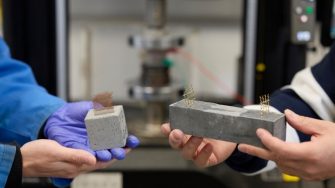Giving concrete a brain
A/Prof. Wengui Li’s team is testing cement-based sensors that detect microscopic cracks in the hopes they can be repaired before getting worse.
A/Prof. Wengui Li’s team is testing cement-based sensors that detect microscopic cracks in the hopes they can be repaired before getting worse.

Concrete is vital for our working world. Around 70 per cent of the world’s population, opens in a new window lives in a structure built with concrete. The composite is second only to water for use in construction, and its production is responsible for more than 8 per cent of the world’s total carbon emissions, opens in a new window.
Scientia Associate Professor Wengui Li, in the School of Civil and Environmental Engineering, is a researcher looking to conquer concrete by making it work harder and smarter to address increasing use and reduce its environmental impact.
This is where ‘smart concrete’ comes in. From cement-based sensors that detect cracks the naked eye can’t see, to self-healing mixtures that repair hairline cracks by themselves, A/Prof. Li is breathing life into the block.
A/Prof. Li’s team is testing cement-based sensors that detect microscopic cracks in the hopes they can be repaired before getting worse.
The sensors are made of conductive materials and measure ‘piezoresistivity’, a material’s change in electrical resistance when pressure or weight is applied. Hooked up to cables, the sensors send data that warn about cracks based on how dramatically the resistivity changes as power surges through the sensors.
A/Prof. Li says the sensors could assist in the maintenance of large apartment buildings.
“It offers advantages like high sensitivity. The cost is low, the durability is better, it means it can be used for a longer time.
“It's far better to act early on cracks in structures. Leaving it too late can lead to demolishing.”
Identifying cracks is one thing, but then the repair work begins.
Reinforced concrete is concrete with steel bars inside and the foundation for most structures we use today. It can have a life-span as short as 50 years before it starts to decay.
‘Concrete cancer’ happens when the steel inside reinforced concrete starts to rust. Concrete is porous and moisture seeping in can cause the steel to expand, with the concrete cracking against the pressure.
A/Prof. Li and collaborating researchers have successfully added a crystalline mixture to concrete that has shown healing in hairline cracks after a fortnight.
He says using self-healing concrete not only means safer structures but “has an added effect of reducing emissions by cutting down on cement production”.
“If we can solve this problem, we can improve the durability and extend the service life of the concrete to more than 100 years.”
But there is an irony with his self-healing mixture: it must be exposed to water to work.
A/Prof. Li says the next 10-20 years will be big for concrete that does more than just provide a foundation.
“After trying to make concrete stronger and more durable, the next research will focus on the multifunctional.
“Soon, more and more innovations will be moved out of labs and into the field for commercialisation.”

As Australia’s best engineering faculty turns 75, there are just as many reasons why we’ve earned that title. Discover new stories weekly, celebrating the successes that have enabled progress for all.
